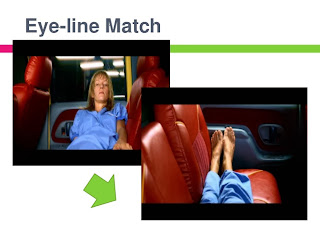Why is Continuity Editing important ?
It helps retain a sense of realistic chronology generates the feeling that time is moving forward. It doesn't mean you can't use a flashbacks or flash forwards, as long as the narrative will still be seen to be progressing forward in an expected or realistic way.
Eye-line match

- This technique links two shots together
- We see a character looking at something off screen and then we cut to a shot of what they are looking at.
- This allows the audience to experience an event in film just as the character is experiencing it.
The 180 Degree Rule
Marching on Action
- Links two shots together.
- We see a character start an action in one shot, the camera he cuts to a different angle and we see the character finish the action in the second shot.
- This technique ensures that the action seems like one natural and realistic movement even when the actor may have already performed it twice.
Shot, Reverse Shot
- Links two shots together.
- The first shot reveals one character and then the second shot reveals the second character.
- This allows the audience to connect the two characters and realise that they are interacting with each other.
Continuity Editing
Evaluation - This continuity clip was a short film involving 2 females. The purpose of this clip was to show that we understood the different techniques that we were taught, and that we always knew how to use them correctly whilst filming.
For example, at the beginning of the film we used, Eye-line match, this was when Toni looked up and then there was a view of what she was looking at, the clock. This technique is effective because, it was done correctly and allows the audience to know what Toni was looking at.
The second technique we used was, Match on action, this is when link two shots together


